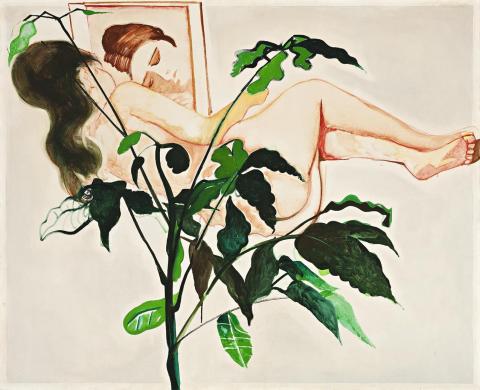NUDE AND MIRROR, 1971
CHARLES BLACKMAN
oil and synthetic polymer paint on canvas
137.0 x 168.0 cm
signed and dated upper right: CHARLES BLACKMAN 1971
Auguste Blackman, Sydney, the artist’s son
Private collection, acquired from the above c.1983 – 84
Lawsons, Sydney, 11 April 2000, lot 186 (as ‘Nude with Mirror’)
Private collection, Sydney
Amadio, N., Charles Blackman Lost Domains, Alpine Fine Arts Collection, New York, 1980, cat. 8.2, p. 114 (illus.)
The early seventies were an important time of consolidation and transition for Charles Blackman. Following extended periods spent in Paris and London, the artist and his young family returned to Australia in 1971, settling in Paddington, Sydney. The artist’s wife Barbara had succumbed to complete blindness, cutting her off from his visual world. In the face of this crisis, Blackman diverted from previous themes of encroaching blindness and domesticity, increasingly turning toward objective, tangible subjects, including a series of nudes in 1971 – 72. For the first time since his life drawing classes nearly three decades earlier, Blackman worked with models, believing the series to be among his most relaxed paintings. ’A model is a classic form of relaxation. It takes your eyes from your inner world and turns them outward. Your eyes are being poetic’.1
The inviting lyricism of flowers and gardens was a leitmotif much loved by the artist. Though Blackman had moved beyond the ambitious White Cat's Garden trilogy of 1968, the vitality and colour of the florals remained a lasting inspiration. In his 1989 biography of Blackman, Thomas Shapcott hailed the flower paintings as his most celebrated, describing the subject 'as a long series of inventions on a theme capable of infinite variety within the form'.2 Nude and Mirror, 1971 indeed demonstrates such variety, with the artist opting to obscure the nude figure, not with the characteristic florals, but with luscious emerald leaves. The vivid foliage has here become the very centre of expression, a feature of all garden and floral paintings, noted by Shapcott as ‘cultivated presences, sufficient unto themselves, yet always the product of caring, tending, civilising application’.3
The soft shapes of the woman, her pink skin luminous against the contrasting verdure of the foreground, suffuse the painting with ethereal beauty. The figure and foliage, set against a primary background of warm grey, is a composition favoured by Blackman for its intimacy and simplicity. Inspired by the work of French Symbolist painter, Odilon Redon, Blackman favoured the stillness of his compositions, and the ambiguous, indeterminable nature of his backdrops. Here, the mood is introspective, the reflection of the mirror drawing the viewer toward a secretive encounter which is both melancholic and romantic. The viewer remains excluded from the private moment, with the figure turning her back, obfuscated by foliage. The closed eyes, a motif often inspired by Barbara's blindness, heightens the sensitivity and vulnerability of the model.
Though experiencing a somewhat turbulent period in his personal life, with his marriage under pressure, the artist nevertheless stated that he was particularly happy while painting with the life models. Delighting in the mere presence of another human being in the studio, Blackman stated that ’there is nothing more lovely than a beautiful creamy nude’.4
1. Amadio, N., Charles Blackman: The Lost Domains, A.H. & A.W. Reed, Sydney, 1980, p. 117
2. Shapcott, T., The Art of Charles Blackman, Andre Deutsch, London, 1989, p. 28
3. ibid., p. 53
4. Amadio, N., op. cit.
MELISSA HELLARD
